Microsoft MD-101 Managing Modern Desktops Online Training
Microsoft MD-101 Online Training
The questions for MD-101 were last updated at Dec 13,2025.
- Exam Code: MD-101
- Exam Name: Managing Modern Desktops
- Certification Provider: Microsoft
- Latest update: Dec 13,2025
Topic 4, Misc. Questions
HOTSPOT
Your network contains an Active Directory domain that is synced to Microsoft Azure Active Directory (Azure AD).
You have a Microsoft Office 365 subscription. All computers are joined to the domain and have the latest Microsoft OneDrive sync client (OneDrive.exe) installed.
On all the computers, you configure the OneDrive settings as shown in the following exhibit.
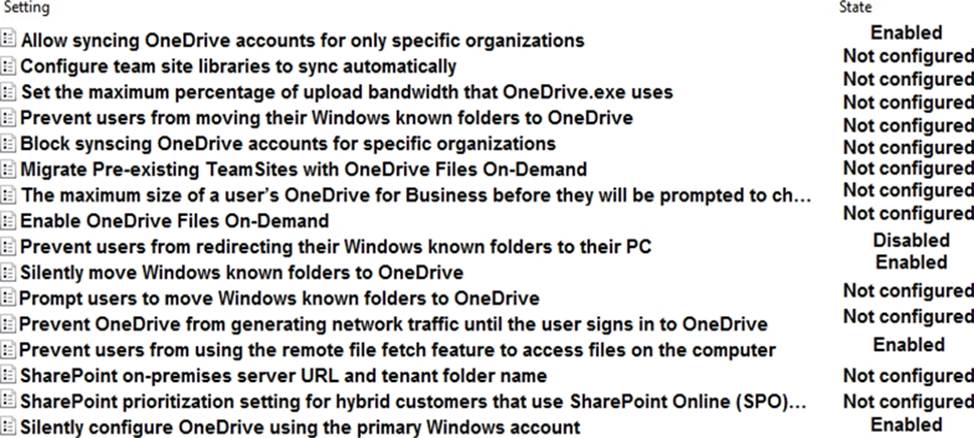
Use the drop-down menus to select the answer choice that completes each statement based on the information presented in the graphic. NOTE: Each correct selection is worth one point.


Explanation:
Box 1:
Silently move known folders to OneDrive is enabled. Known folder include:
Desktop, Documents, Pictures, Screenshots, and Camera Roll
Box 2:
OneDrive Files On-Demand enables users to view, search for, and interact with files stored in OneDrive from within File Explorer without downloading them and taking up space on the local hard drive.
References:
https://docs.microsoft.com/en-us/onedrive/redirect-known-folders
https://docs.microsoft.com/en-us/onedrive/plan-onedrive-enterprise
HOTSPOT
You have an Azure Active Directory (Azure AD) tenant named adatum.com that contains the users shown in the following table.

You configure the following device settings for the tenant:
✑ Users may join devices to Azure AD: User1
✑ Additional local administrators on Azure AD joined devices: None
You install Windows 10 on a computer named Computer1.
You need to identify which users can join Computer1 to adatum.com, and which users will be added to the Administrators group after joining adatum.com.
Which users should you identify? To answer, select the appropriate options in the answer area. NOTE: Each correct selection is worth one point.
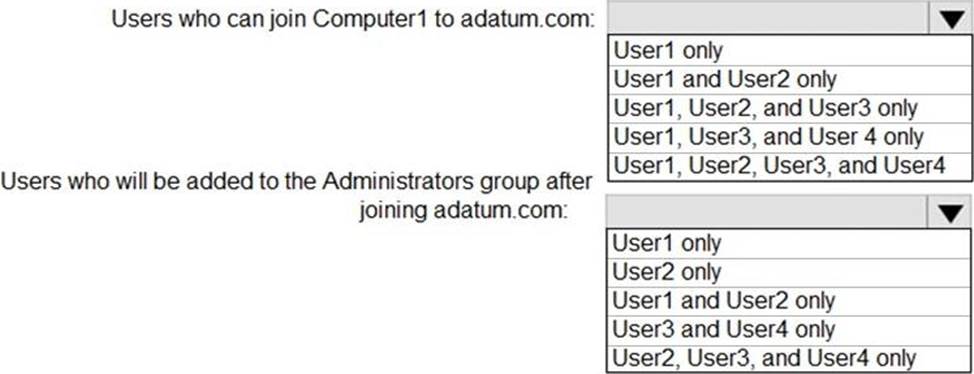
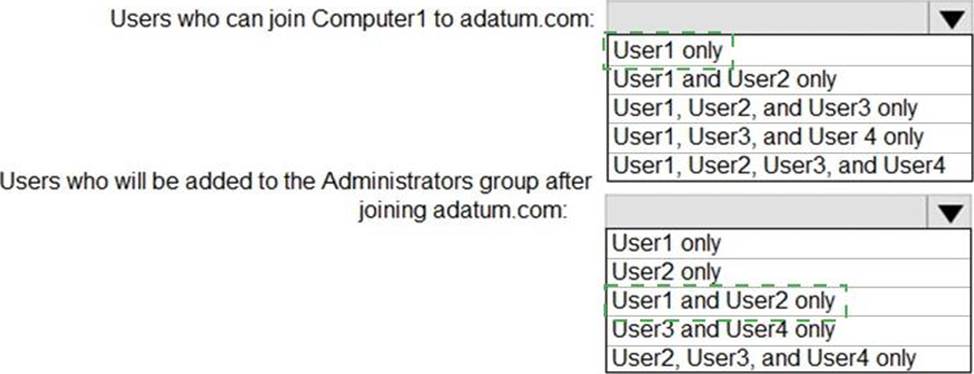
HOTSPOT
You have a Microsoft Deployment Toolkit (MDT) solution that is used to manage Windows 10 deployment tasks.
MDT contains the operating system images shown in the following table.

You need to perform a Windows 10 in-place upgrade on several computers that run Windows 8.1.
From the Deployment Workbench, you open the New Task Sequence Wizard.
You need to identify which task sequence template and which operating system image to use for the task sequence. The solution must minimize administrative effort.
What should you identify? To answer, select the appropriate options in the answer area. NOTE: Each correct selection is worth one point.
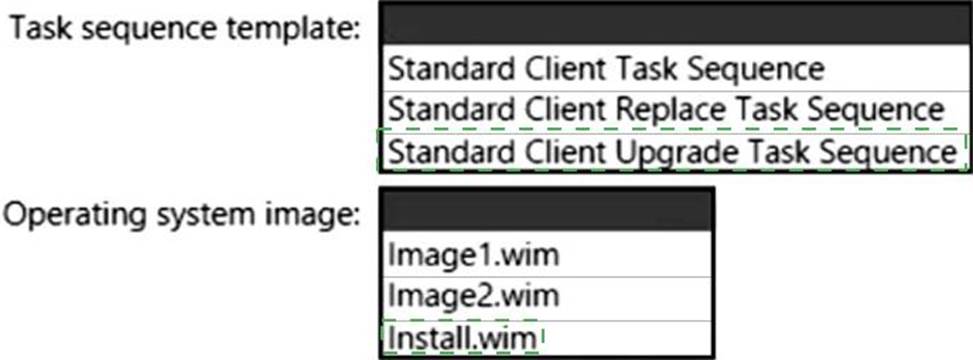
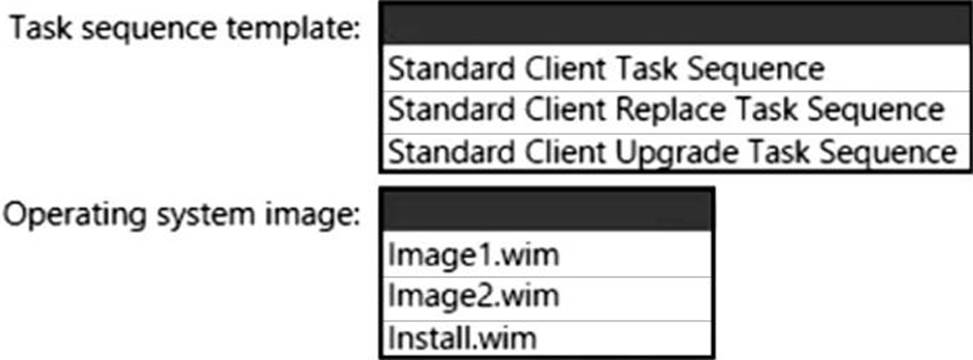
Explanation:
Box 1: Standard Client Upgrade Task Sequence
Use Template: Standard Client Upgrade Task Sequence
In-place upgrade is the preferred method to use when migrating from Windows 10 to a later release of Windows 10, and is also a preferred method for upgrading from Windows 7 or 8.1 if you do not plan to significantly change the device’s configuration or applications. MDT includes an in-place upgrade task sequence template that makes the process really simple.
Box 2: Install.wim
In-place upgrade differs from computer refresh in that you cannot use a custom image to perform the in-place upgrade. I
HOTSPOT
You have computers that run Windows 10 and are configured by using Windows AutoPilot.
A user performs the following tasks on a computer named Computer1:
✑ Creates a VPN connection to the corporate network
✑ Installs a Microsoft Store app named App1
✑ Connects to a Wi-Fi network
You perform a Windows AutoPilot Reset on Computer1.
What will be the state of the computer when the user signs in? To answer, select the appropriate options in the answer area. NOTE: Each correct selection is worth one point.
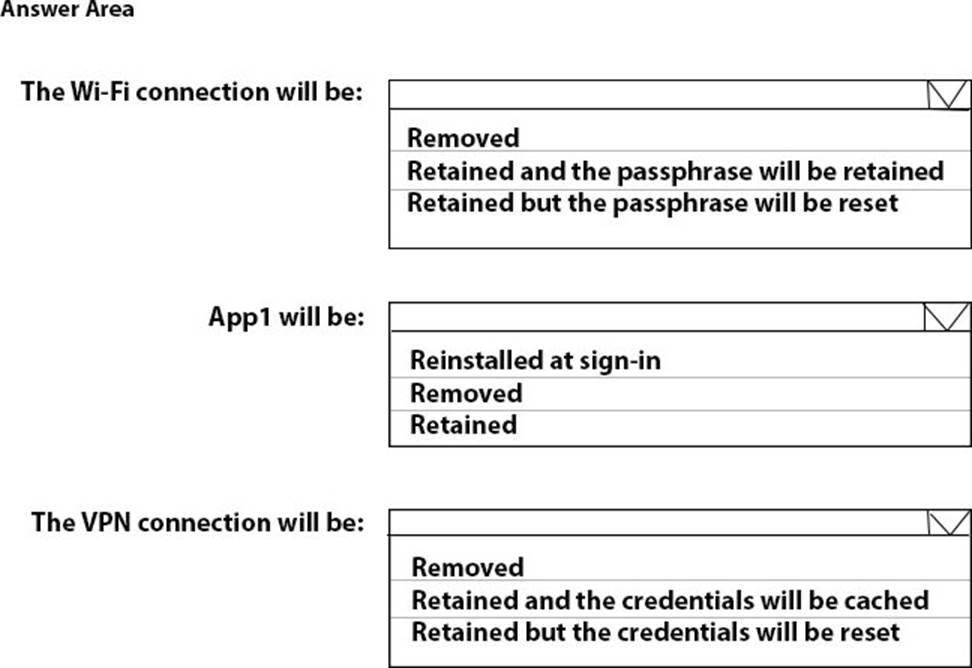
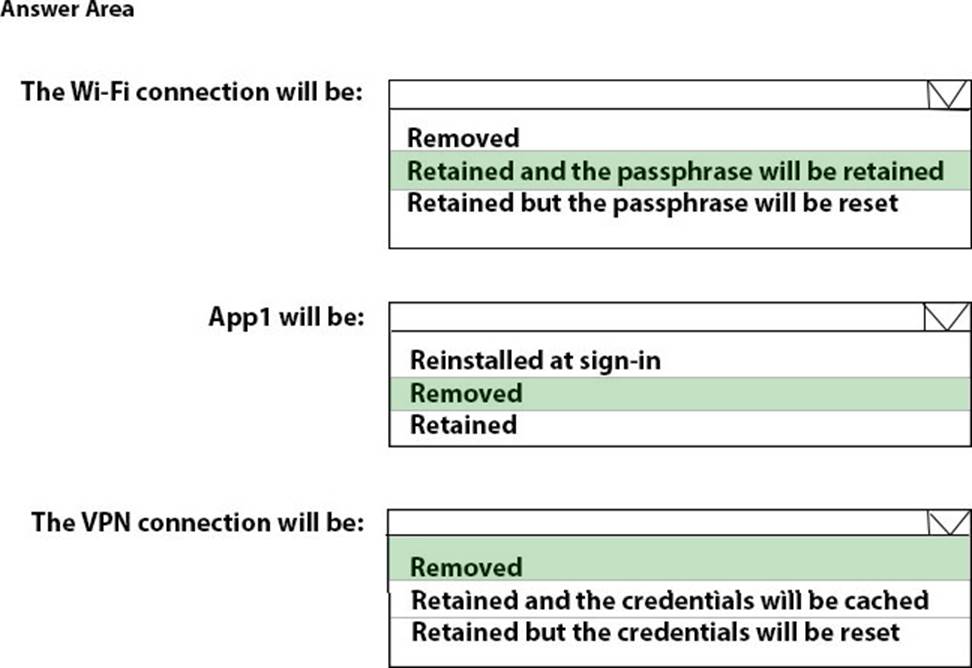
You have a Microsoft 365 E5 subscription and 150 Windows 10 devices.
All the devices are enrolled in Microsoft Intune.
You need to use Intune to apply Windows updates to the devices.
What should you do first?
- A . From the Microsoft Endpoint Manager admin center, configure scope tags.
- B . Create a device restriction policy that has telemetry set to the minimum setting of Required
- C . From the Microsoft Endpoint Manager admin center, configure a security baseline.
- D . Create a device restriction policy that has telemetry set to Security (Enterprise Only).
You have devices enrolled in Microsoft Intune as shown in the following table.
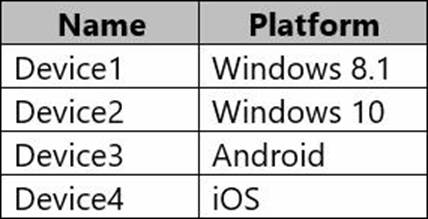
On which devices can you apply app configuration policies?
- A . Create an Azure Active Directory group that contains all users.
- B . From the Intune portal, create a Microsoft Store app for the Remote Desktop modern app.
- C . From the Intune portal assign the app to the Azure Active Directory group.
- D . Create an Azure Active Directory group that contains the Windows 10 devices.
- E . From the Microsoft Store for Business portal, assign a license for the app to all the users in the Azure Active Directory group.
- F . For your organization, make the app available in the Microsoft Store for Business.
B,C,D
Explanation:
Reference:
https://docs.microsoft.com/en-us/mem/intune/apps/apps-add
https://docs.microsoft.com/en-us/mem/intune/apps/apps-deploy
https://docs.microsoft.com/en-us/mem/intune/apps/windows-store-for-business
You have 100 devices that run Windows 10 and are joined to Microsoft Azure Active Directory (Azure AD).
You need to prevent users from joining their home computer to Azure AD.
What should you do?
- A . From the Device enrollment blade in the Intune admin center, modify the Enrollment restriction settings.
- B . From the Devices blade in the Azure Active Directory admin center, modify the Device settings.
- C . From the Device enrollment blade in the Intune admin center, modify the Device enrollment manages settings.
- D . From the Mobility (MDM and MAM) blade in the Azure Active Directory admin center, modify the Microsoft Intune enrollment settings.
B
Explanation:
References: https://docs.microsoft.com/en-us/intune/enrollment-restrictions-set
Note: This question is part of a series of questions that present the same scenario. Each question in the series contains a unique solution that might meet the stated goals. Some question sets might have more than one correct solution, while others might not have a correct solution.
After you answer a question in this section, you will NOT be able to return to it. As a result, these questions will not appear in the review screen.
You have a computer that runs Windows 8.1.
Two days ago, you upgraded the computer to Windows 10.
You need to downgrade the computer to Windows 8.1.
Solution: From Windows Update in the Settings app, you use the Advanced options.
Does this meet the goal?
- A . Yes
- B . No
Note: This question is part of a series of questions that present the same scenario. Each question in the series contains a unique solution that might meet the stated goals. Some question sets might have more than one correct solution, while others might not have a correct solution.
After you answer a question in this section, you will NOT be able to return to it. As a result, these questions will not appear in the review screen.
Your company has an Azure Active Directory (Azure AD) tenant named contoso.com that contains several Windows 10 devices.
When you join new Windows 10 devices to contoso.com, users are prompted to set up a four-digit pin.
You need to ensure that the users are prompted to set up a six-digit pin when they join the Windows 10 devices to contoso.com.
Solution: From the Azure Active Directory admin center, you modify the User settings and the Device settings.
Does this meet the goal?
- A . Yes
- B . No
B
Explanation:
Instead, from the Azure Active Directory admin center, you configure automatic mobile device management (MDM) enrollment. From the Device Management admin center, you configure the Windows Hello for Business enrollment options.
Reference: https://docs.microsoft.com/en-us/intune/protect/windows-hello
You have a Windows 10 device named Device1 that is joined to Active Directory and enrolled in Microsoft Intune.
Device 1 is managed by using Group Policy and Intune.
You need to ensure that the Intune settings override the Group Policy settings.
What should you configure?
- A . a device configuration profile
- B . an MDM Security Baseline profile
- C . a device compliance policy
- D . a Group Policy Object (GPO)
A
Explanation:
Reference: https://uem4all.com/2018/04/02/windows-10-group-policy-vs-intune-mdm-policy-who-wins/
Latest MD-101 Dumps Valid Version with 238 Q&As
Latest And Valid Q&A | Instant Download | Once Fail, Full Refund

